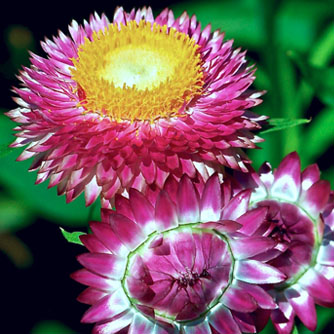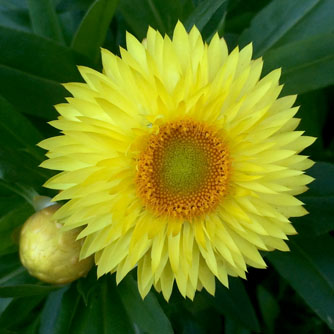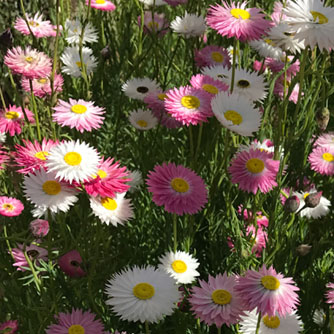Strawflowers & Paper Daisies
BackStrawflowers, everlasting daisies and paper daisies are all Australian natives which provide great colour in the garden and offer something a little different instead the usual annuals. They belong to the Asteraceae family and their common names refer to the papery, dry bracts which surround the flowers. The flowers last a long time, make fabulous cut flowers and are often used in dried flower arrangements.
There are several different types of paper daisies and unfortunately it can get a bit messy because the botanists keep changing their names! However they can generally be divided into two main groups: annuals and short-lived perennials.
Annuals
Rhodanthe chlorocephala and Schoenia filifolia are probably the best known examples and usually get called everlasting or paper daisies. Rhodanthe flowers have yellow or black centres with bracts in several shades of pink. Schoenia flowers are all bright yellow. Both types are narrow upright plants which grow to about 40cm high. They look best when planted in large groups. Flowering is mainly in Spring with plants dying off with the heat of Summer.

Pink strawflowers
Short-lived Perennials
Xerochrysum, Bracteantha and Helichrysum are all names used for these perennials but normal people just call them strawflowers! Whilst they are perennials they tend to only perform well for a year or two and then need replacing. Think of them as long-lived annuals instead
Flowers mostly have golden centres with bracts of differing colours including yellow, orange, brown, pinks and burgundy red. Strawflowers are bushier plants compared to paper daisies and will grow up to 80cm tall. Flowering occurs from Spring right through into Autumn.
How To Grow Strawflowers
Strawflowers and paper daisies are fast growing, low maintenance plants. They require full sun and whilst they can take a range of soils, last longer in fertile soil with good drainage. To keep them flowering longer (especially the annual types) it is best to not let the soil dry out completely. Add an organic compost to the soil and if you’re planting into clay apply gypsum before planting to improve the drainage.
The annual paper daisies should be grown from seed. Occasionally nurseries sell seedlings in punnets but these rarely perform well. Sow seed directly onto the soil and very lightly cover. Keep moist and they’ll germinate easily. Failure to germinate is almost always due to drying out. Apply OCP eco-hydrate at the time of sowing to minimise this problem.
The perennial strawflowers are usually sold as individual plants already in bud or flower. Just plant and water in with OCP eco-seaweed to minimise transplant shock and get new roots developing quickly.

Yellow strawflowers
Fertilising Strawflowers
Regular light feeds every 2-3 weeks with a mixture of OCP eco-aminogro and OCP eco-seaweed will produce strong healthy plants with large blooms. Even though they are natives and can survive with little nutrients they put on a much better floral show if given plenty of food.
Pruning Strawflowers
The annuals require no pruning at all but the occasional light pruning of the taller growing perennials will help to keep them shape. Cutting flowers for the vase is a great way to achieve this!
Pest & Disease Problems with Strawflowers
Strawflowers are generally easy to grow and don’t have too many problems.
- Snails and slugs - Watch out for these pests when seedlings are young and apply OCP eco-shield pellets as required.
- Aphids - control these sap suckers with sprays of OCP eco-oil or OCP eco-neem.
- Powdery mildew - if this disease rears its ugly head (especially later in the growing cycle) spray with an organic fungicide.

Pink and white paper daisies



